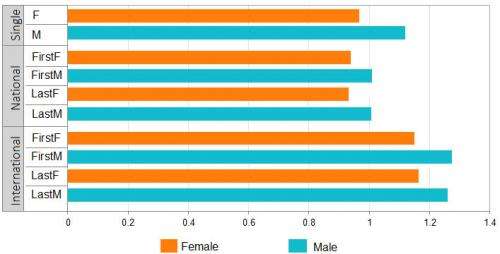Women's presence in science is not reflected in peer-review authorship or citations

After reviewing the authorship of 5.4 million peer-reviewed articles, University of Montreal information scientist Prof Vincent Larivière and colleagues from UQAM and University of Indiana have established that women are seriously under-represented within the academic publishing system. "Although female students outnumber males, we know that professors are overwhelmingly male and so is both the authorship and citation of research papers. For every article with a female first-author, there are nearly two articles first-authored by men," Larivière said. "This study is the first to actually quantify this disparity across disciplines and around the world. The problem persists despite a concerted effort to correct it – we cannot address an issue properly until we understand it. And the exclusion of half of the planet's brains is a very serious problem indeed." Their findings were published today in Nature.
The researchers retrieved scientific articles published between 2008 and 2012 from the Web of Science database, which includes the authors' names and affiliations. Some kinds of academic articles that are not generally peer-reviewed or considered as "original contributions to scholarly knowledge" were excluded, such as letters to the editor and book reviews. Then authorship was scored, taking into the account the importance of researcher's position as senior author, first author, and so forth. Finally, to determine the gender composition of the articles, the researchers compiled lists of names, using sources such as the US Census, and wrote database search formulas (for example, Russian men's names tend to end with -ov, -ev or –in, women's with -ova, -eva or –ina.) The researchers were able to assign the gender of 65.2% of the 27 million authorships they analyzed.
The findings confirmed most anecdotal perceptions but also destroyed a few. "In North America, Western Europe and other highly productive research countries, we found that all articles with women in dominant author positions receive fewer citations than those with men in the same positions," Larivière explained. "Moreover, women had less international collaborations than men – international collaborations typically improve the likelihood of being cited." This was not found to be the case in countries in South America and Eastern Europe. The researchers attribute the difference to the focus on gender parity associated with former Communist countries.
The study also looked at regional differences within countries and between academic disciplines. "Vermont, Rhode Island, Maine, Manitoba, Nova Scotia, and Quebec came closest to achieving gender parity; New Mexico, Mississippi, and Wyoming are at the other end of the spectrum," Larivière said. "With regards to areas of research, our disciplinary results confirmed previous findings and anecdotal knowledge about fields associated with 'care'. Women dominate disciplines like nursing, education, and social work. Military sciences, engineering, mathematics, computer science, and economics remain the preserve of men, as do in fact the humanities." Other disciplines where gender is particularly imbalanced include, in the favour of women, midwifery, librarianship, speech language and hearing, and in the favour of men, robotics, aeronautics and astronautics high-energy physics, and philosophy.
Although this study does not explain why the gender-disparity exists, the researchers feel that it raises further questions that may help define measures that could be taken to better understand and address the situation. "Given that citations now play a central role in the evaluation of researchers, this situation can only worsen gender disparities," Larivière said. "We should look more closely at the work itself to determine if there are characteristics that contribute more to these disparities. Perhaps there are less quantitative, aspects of scholarship that reveal a different story regarding gender disparities in science. And it is possible that there is something intrinsic to certain disciplines that make them more or less appealing to scientists of a particular sex."
More information: Vincent Larivière, Chaoqun Ni, and Cassidy R. Sugimoto contributed equally to "Global gender disparities in science," which they published in Nature on December 11, 2013. www.nature.com/doifinder/10.1038/504211a
Journal information: Nature
Provided by University of Montreal
















